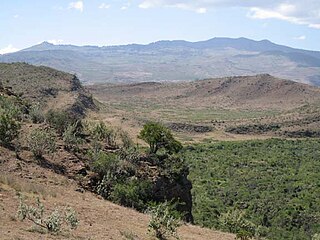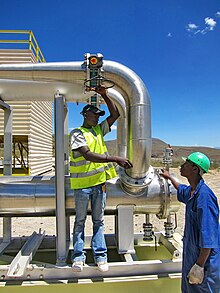
Geothermal energy is the thermal energy in the Earth's crust which originates from the formation of the planet and from radioactive decay of materials. The high temperature and pressure in Earth's interior cause some rock to melt and solid mantle to behave plastically. This results in parts of the mantle convecting upward since it is lighter than the surrounding rock. Temperatures at the core–mantle boundary can reach over 4000 °C (7200 °F).

The developing nations of Africa are popular locations for the application of renewable energy technology. Currently, many nations already have small-scale solar, wind, and geothermal devices in operation providing energy to urban and rural populations. These types of energy production are especially useful in remote locations because of the excessive cost of transporting electricity from large-scale power plants. The applications of renewable energy technology has the potential to alleviate many of the problems that face Africans every day, especially if done in a sustainable manner that prioritizes human rights.

Geothermal power is electrical power generated from geothermal energy. Technologies in use include dry steam power stations, flash steam power stations and binary cycle power stations. Geothermal electricity generation is currently used in 26 countries, while geothermal heating is in use in 70 countries.

Kenya Electricity Generating Company PLC abbreviated to KenGen, is a government enterprise in the Republic of Kenya charged with the production of electricity for the country. KenGen is the largest electric power producer in Kenya, generating over 60% of the electricity consumed in the country.
The Olkaria I Geothermal Power Station, also known as Olkaria I Geothermal Power Plant is a geothermal power station in Kenya, with an installed capacity of 268.3 megawatts (359,800 hp).

The Olkaria III Geothermal Power Station, also known as 'OrPower 4' is a large geothermal power plant in Kenya, having an installed electricity generating capacity of 139 megawatts (186,000 hp).

Ol Doinyo Eburru is an active complex of volcanoes in the Great Rift Valley, Kenya to the northwest of Lake Naivasha. It is being exploited for geothermal energy. Soysambu Conservancy is located to the north of the massif, between Lake Elmenteita to the east and Lake Nakuru to the west.

The Olkaria Area is a region located immediately to the south of Lake Naivasha in the Great Rift Valley of Kenya, Africa. It is geothermally active and is being used to generate clean electric power. The region has an estimated potential of 2,000 MW. This is almost double the maximum daily electricity peak demand recorded in 2008/2009 for the entire country.

This article describes energy and electricity production, consumption, import and export in Kenya. Kenya's current effective installed electricity capacity is 2,651 megawatts (MW), with peak demand of 1,912 MW, as of November 2019. At that time, demand was rising at a calculated rate of 3.6 percent annually, given that peak demand was 1,770 MW, at the beginning of 2018. Electricity supply is mostly generated by renewable sources with the majority coming from geothermal power and hydroelectricity.
Despite its high potential for wind energy generation, wind power in Kenya currently contributes only about 16 percent of the country's total electrical power. However, its share in energy production is increasing. Kenya Vision 2030 aims to generate 2,036 MW of wind power by 2030. To accomplish this goal, Kenya is developing numerous wind power generation centers and continues to rely on the nation's three major wind farms: the Lake Turkana Wind Power Station, the Kipeto Wind Power Station, and the Ngong Hills Wind Farm. While these wind power stations are beneficial to help offset fossil fuel usage and increase overall energy supply reliability in Kenya, project developments have also negatively impacted some indigenous communities and the parts of the environment surrounding the wind farms.

Most of Kenya's electricity is generated by renewable energy sources. Access to reliable, affordable, and sustainable energy is one of the 17 main goals of the United Nations’ Sustainable Development Goals. Development of the energy sector is also critical to help Kenya achieve the goals in Kenya Vision 2030 to become a newly industrializing, middle-income country. With an installed power capacity of 2,819 MW, Kenya currently generates 826 MW hydroelectric power, 828 geothermal power, 749 MW thermal power, 331 MW wind power, and the rest from solar and biomass sources. Kenya is the largest geothermal energy producer in Africa and also has the largest wind farm on the continent. In March 2011, Kenya opened Africa's first carbon exchange to promote investments in renewable energy projects. Kenya has also been selected as a pilot country under the Scaling-Up Renewable Energy Programmes in Low Income Countries Programme to increase deployment of renewable energy solutions in low-income countries. Despite significant strides in renewable energy development, about a quarter of the Kenyan population still lacks access to electricity, necessitating policy changes to diversify the energy generation mix and promote public-private partnerships for financing renewable energy projects.
The Akiira One Geothermal Power Station, is a proposed 70 MW (94,000 hp) geothermal power plant in Kenya, the largest economy in the East African Community.
The Menengai I Geothermal Power Station is a 35 MW (47,000 hp) geothermal power plant under construction in Kenya. The power station is owned and is being development by a consortium, which has formed a special vehicle company (SPV) to own, design, build, finance, operate and maintain the power station. For descriptive purposes, we will call that SPV Orpower Twenty Two (OP22). Kenya Power and Lighting Company, the off-taker together with OP22, the independent power producer (IPP), plan to sign a 20-year power purchase agreement.
Menengai II Geothermal Power Station, is a 35 MW (47,000 hp) geothermal power station under construction in Kenya. The power station is owned and under development by Globeleq, an independent power producer headquartered in London, United Kingdom. Globeleq is 70 percent owned by British International Investment and 30 percent by Norfund.
The Menengai III Geothermal Power Station is a 35 MW (47,000 hp) geothermal power plant under construction in Kenya.
The Olkaria IV Geothermal Power Station is an operational geothermal power plant in Kenya, with installed capacity of 140 megawatts (190,000 hp).
The Tulu Moye Geothermal Power Station, is a 50 MW (67,000 hp) geothermal power station, under construction in Ethiopia. When fully developed, the power station will be the first grid-ready independently developed geothermal power station in the country. The developers of this power plant, plan to expand it to 150 megawatts capacity, in the second phase, planned in the following five years.
The Corbetti Geothermal Power Station, is a 500 MW (670,000 hp) geothermal power station, under construction in Ethiopia. When fully developed, the power station will be the largest grid-ready independently developed geothermal power station in the country. The developers of this power plant plan to expand it from 10 megawatts to 60 megawatts, then to 500 megawatts and to possibly 1,000 MW. They have given themselves until 2030 to complete this renewable energy development.
The Olkaria VI Geothermal Power Station, also known as the Olkaria VI Geothermal Power Plant, is a power station under construction in Kenya, with an electric capacity of 140 megawatts. The plant will be developed under a public private partnership (PPP) model, where the state-owned Kenya Electricity Generating Company (KenGen) will co-own the power station with a strategic partner.
The Olkaria VII Geothermal Power Station, also known as the Olkaria VII Geothermal Power Plant, is a proposed geothermal power station in Kenya. The feasibility studies which will inform the design and generation capacity of this renewable energy infrastructure is ongoing, as of March 2022. The proposed generation capacity ranges from 83 megawatts, to 140 megawatts. The plant is owned and under development by Kenya Electricity Generating Company (KenGen), the electricity generation parastatal in Kenya.










